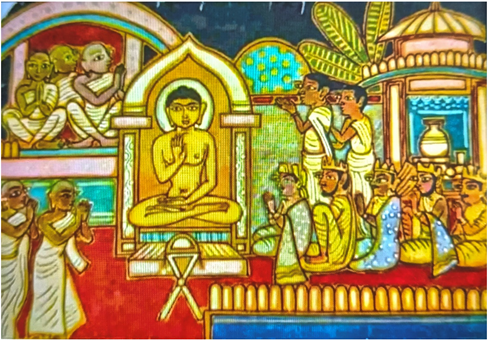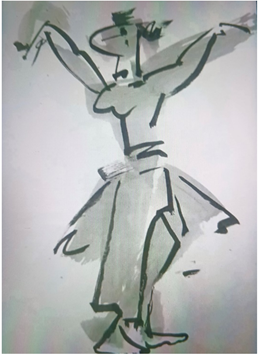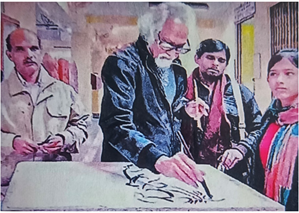|
|
|
|
|
REFLECTION OF INDIAN HERITAGE IN THE ART OF CONTEMPORARY ARTIST J. RAJ DASSANI
Pooja Kumawat 1![]() , Dr. Kumkum Bharadwaj 2
, Dr. Kumkum Bharadwaj 2
1 Research
Scholar, Government Maharani Laxmi Bai Girls P.G. College, Kila Bhawan, Devi
Ahilya Vishwavidyalaya, Indore (M.P.), India
2 Head
and Professor, Government Maharani Laxmi Bai Girls P.G. College, Kila Bhawan,
Devi Ahilya Vishwavidyalaya, Indore (M.P.), India
|
|
ABSTRACT |
||
|
India is the land of diverse
cultures. Different colors of these Indian cultures have been preserved in
the guise of heritage. Many prestigious museums and monuments as Indian
heritage exist in the country today. The religious manuscripts, paintings,
sculptures, and many more displayed in these are an integral part of the
heritage. Through the presented research
paper, the reflection of these Indian heritages has been explored in the art
of contemporary artist J. Raj Dasani. To achieve this objective, art
catalogues, newspaper pages and other reliable sources have been observed and
studied. For authenticity, the artist has been discoursed through a personal
interview, in which artist cooperated wholeheartedly. Before proceeding with research work
in the direction of objective, an introduction of the Indian heritage and
enriched artistic life of the artist is given in brief. Apart from being a
celebrated artist, J. Raj is also an accomplished sculptor. His art pieces
have been exhibited in many prestigious galleries in the country and abroad
in which his art received immense praise. He has been continuously exploring
his artistic abilities by doing new experiments in his art. He has made a
special niche for himself in the art world due to his brilliant brush
strokes. The concept of J. Raj’s "Virasat
se Jugalbandi" workshop has set a prototype in
the art world in which Indian heritage is the inspiration behind the artworks
created. How this experimental contemporary artist has assimilated the
reflection of Indian heritage with modernity in his art has attempted through
this research paper. |
|||
|
Received 15 August 2025 Accepted 21 September 2025 Published 03 November 2025 Corresponding Author Pooja
Kumawat, poojakumawat21193@gmail.com DOI 10.29121/ShodhShreejan.v2.i2.2025.34 Funding: This research
received no specific grant from any funding agency in the public, commercial,
or not-for-profit sectors. Copyright: © 2025 The
Author(s). This work is licensed under a Creative Commons
Attribution 4.0 International License. With the
license CC-BY, authors retain the copyright, allowing anyone to download,
reuse, re-print, modify, distribute, and/or copy their contribution. The work
must be properly attributed to its author.
|
|||
|
Keywords: Contemporary
Artist, J. Raj Dassani, Artist, Indian heritage, Virasat, Jugalbandi |
|||
1. INTRODUCTION
India, a country prevalent for its enormous history and cultural diversity, has a reservoir of avidly important heritage monuments of several ancient sites Bhasin et al. (n.d.). Whatever exist as inheritance from the past is Indian heritage for the current generation i.e. us. The extremely rich and extensive Indian heritage and its culture is unique and has survived for thousands of years Ramaswamy (2008). Indian heritage is the congenial intermingle of philosophy, religion and art.
The various religious and historical places, monuments, museums, manuscripts, work of art, artifacts and many more grew in India are tangible heritage, which draw attention of the people throughout the world. India is rich in museums in which heritage is preserved in the form of sculptures, artefacts, paintings etc. Intangible heritage includes tradition, language, folklore, knowledge, popular music and dance styles and such other aspects accepted as Indian heritage Bheemraju (n.d.). The reflection of the painted folios of Jain manuscripts, paintings of World Heritage Site Ajanta caves and preserved statues and artefacts of museums are visible in the artworks of contemporary artist J. Raj Dassani.
Jawarchand Dassani, famous in the art populace as J. Raj Dassani was born in the Khargone district of Madhya Pradesh in 1943. He received primary education from the school in Barwaha village of Khargone district. For further education, he attended residential school in Indore from 1953 to 54. Inquisitive nature towards art was visible in him since his school days. The celebrated artist and his art mentor Ramji Verma recognized his genius and inspired him to pursue higher learning from the prestigious Shantiniketan Art Institute. Admitted here as an art student in 1962, the art skills of this budding artist further enhanced till 1966, this time period paved the way for him in the art world.
At Shantiniketan, the artistic voyage of J. Raj got the excellent start under the influence of art master’s like Nandalal Bose, Surendranath Ganguly, Sudhir Ranjan Khastgir and Kiran Singh. It was his good fortune to be trained by stalwarts like Binode Behari Mukherjee and Ramkinkar Baij. He has inherited the specialties of dynamic line, composition sense, fluent brush strokes from these giants. His art pieces deliver the great rhythm and movement.
In the course of 1966-73, art creations of J. Raj have earned a glorious place in solo exhibitions held in India and abroad such as Indore, Gwalior, Kolkata, Mumbai, Delhi, Detroit (America), New York, Windsor (Canada). Except for this, his works have also been a part of many group displays. Mulk Raj Anand, the former chairman of Lalit Kala Academy, was the first patron of his art. The ‘Empty Canvas’ exhibition held at the Academy of Fine Arts, Kolkata in 1968 is considered to be the peak point of his artistic career, it achieved international fame, so that even the eminent sculptor Henry Moore mentioned it in a lecture he delivered in London.
For almost two and half decades, J Raj has been doing his creative endeavors in Chinese and Japanese painting styles through black ink which is rare innovative genre in India. His art pieces in this genre are thousands in number which reveal his flawless and powerful approach of brush strokes Dassani (n.d.).
J. Raj organized show of his artworks on the invitation of Allahabad Museum in 2018. There he also held the "Virasat se Jugalbandi" through which he provided the unique platform to art lovers that brought together many artists from junior and senior categories and art students. He has done such workshops in Central Museum of Indore, Kolkata, Jabalpur etc. which captured the attention of professional artists not only from India but also from China, Japan and France. Seeing its international success, he has been conducting such workshops. The artworks created in these workshops reflect a unique blend of Indian heritage and brush strokes. The museum’s heritage collection is the inspiration for these artworks Dassani (2023).
Despite incorporating modern elements, the art of J. Raj Dassani remains connected to the Indian roots. This is revealed by the reflection of Indian heritage in his artworks.
2. REFLECTION OF INDIAN HERITAGE IN THE ART OF J. RAJ DASSANI
The art career of J. Raj Dassani had an auspicious beginning in Madhya Pradesh when he returned after art training from Shantiniketan and his artworks were displayed in the Central Museum, Indore. Many prestigious Indian museums have collections of sculptures, artefacts etc. as heritage. The reflection of the heritage of these Indian sculptures was seen in these presented artworks.
J. Raj carried out academic research on Jain manuscripts in 1966 to 1968, influenced by which he also painted on this subject. He has created paintings based on the Jain deities Mahavir Swami and Neminath which were published in a calendar of Kolkata in 1967. Many major Jain manuscripts like Kalpa Sutra, Anga sutra, Trishashti Shalaka Charit, Kathasarit Sagar, Neminath Charit, Nisheeth Churni etc. were painted in Apabhransha style. Abundance of profile faces, protruding eye over the blank space, parval like eyes, pointed nose, double chin, flatly applied colors, use of bright and gold colors etc. are the specialties of the Apabransha style Sharma (2019) which are also apparently visible in the Jain paintings created by J. Raj Image 1. Several important episodes of these Jain manuscripts such as Fourteen dreams of Mahavir’s mother Trishala, Birth of Lord Mahavir and Indra, Sermon of Mahavir Swami, Chandalbala in chains giving alms to Mahavir Swami, Lord Neminath’s marriage renunciation etc. were efficiently depicted on silk in tempera Dassani (2023). As religious manuscripts are also the part of Indian heritage, the Jain miniatures of J. Raj Dassani reflect the Indian heritage as painted folios of the religious Jain manuscripts.
Image 1

|
Image 1 J. Raj Dassani, Sermon of Mahavir Swami, Tempera on Paper Source Artist J.
Raj Dassani |
The World Heritage Site Ajanta caves of India has preserved the rock-cut architecture, sculptures and paintings for centuries. These heritages are dedicated to Lord Buddha. Here in one of the paintings of cave no. 17, Buddha is depicted in larger proportion as compared to his wife Yashodhara and Rahul Sharma (2019). In other cave paintings and sculptures also, Buddha or other divine creatures were shown little larger than rest of the figures. Anyways, it has been the tradition of Indian painting to portray the Gods and Goddesses impressively and in larger proportions to reveal their divinity. Similarly, in the Jain paintings of J. Raj, Lord Neminath and Mahavir Swami have been depicted in a slightly larger anatomy than the rest to show them in divine form. It would not be unfair to say that the reflection of World heritage Site Ajanta caves is visible in his paintings.
The ‘Heritage Walk’ was organized at the Central Museum, Indore in 2015 by Preeta Gadkari, the founder of the Artmate group and artist. J. Raj had an active participation in this workshop. His rapid sketches enthralled all the art students and young artists present there. These sketches were made as inspiration from various Gods and Goddesses and their incarnations exhibited as heritage in the museum Dassani (2023). These creations also undoubtedly present the reflection of Indian heritage Image 2.
Image 2

|
Image 2 J. Raj Dassani, Sketch, Marker on Paper Source Artist
J. Raj Dassani |
Image 3

|
Image 3 J. Raj Dassani, Kathak Sketch, Ink on Paper Source Artist J.
Raj Dassani |
J. Raj has portrayed the ‘Kathak dancers’ in the series of his dance-based artworks Image 3. His Kathak sketches were also published in the brochure of International Kathak Conference 2021, organized by Sri Sri Centre for Advanced Research in Kathak in association with Natvari Kathak Nritya Academy, Indore on the theme of “Kathak and Shastra” Sunkara (2021). Kathak is the heritage of Indian classical dance. He has infused his art with also the reflection of this heritage which has a harmonious blend of rhythm and movement.
Overall, it is fair to say that most of the oeuvre of J. Raj Dassani reflect the Indian heritage of both tangible and intangible kind.
3. INDIAN HERITAGE AS INSPIRATION OF ‘VIRASAT SE JUGALBANDI’ WORKSHOP
The eminent artist J. Raj Dassani, after developing an exclusive style through life long rigorous art practice, is now honing the young talents by giving them the opportunity to paint with him. He is carrying out this task through the "Virasat se Jugalbandi" workshop.
For the first time, J. Raj organized "Virasat se Jugalbandi" workshop in the National Museum of Kolkata. Art students and young artists participated in this two days’ workshop. As a result of its success, the second workshop was also held for three days at the same venue on the humble invitation of the Museum. His accommodation was arranged by the museum itself Dassani (2023).
After that, a five days’ workshop was organized at Allahabad Museum from 31 Dec 2017 to 4 Jan 2018. It was inaugurated by J. Raj Dassani, an artist of Bengal school tradition. He auspiciously started the workshop by drawing a brush stroke sketch of Lord Ganesha ‘Virasat se Jugalbandi’ (2018). Apart from this, he sketched the other statues exhibited in the museum and stated about all the qualities of these statues. In addition to the art students and artists of Allahabad, junior and senior artists of Banaras, Kanpur, Shantiniketan and Kolkata actively participated in it. About ninety drawings were made by J. Raj in just two days for this workshop. His agility and flawless brush strokes left everyone in awe Image 4. He declared such art event to be held every year Shahar ka bujurg chitrakar sikha raha "Virasat se Jugalbandi" karna. (2018). Since then, he has been conducting such workshops in prestigious museums and art centers at various places in the country. It was discussed at the international level and it attracted many leading artists of the country and abroad. "Virasat se Jugalbandi"is like an art movement whose fame is reaching far and wide, every person associated with the art heartily desire to be part of it.
Image 4

|
Image 4 J. Raj Dassani Drawing Line Sketch in Workshop Source Artist J.
Raj Dassani |
Image 5

|
Image 5 J. Raj Dassani and Participant, Artwork (Inspired from Museum’s Heritage Collection), Mix Media on Paper Source Artist J.
Raj Dassani |
"Virasat se Jugalbandi" is an exclusive platform where art aspirants, art students, many budding and professional artists gathered together. The special thing about such a workshop is that J. Raj first draws the line sketches and distributes to the participating artists instead of keeping with himself and they turn these into complete art pieces by giving color scheme. Thus, art is finished by the mutual collaboration of two people that makes the word ‘Jugalbundi’ meaningful. The artworks are signed by both J. Raj and participant Image 5 so that such an amazing art event can be memorized later Dassani (2023).
It is the generosity of this internationally renowned artist that he asks the participating artists to do the rest of work in his line drawings, this has not been seen anywhere else in the art world.
The concept "Virasat se Jugalbandi" is a creative attempt to connect with museum’s heritage. In such workshops, in the figurative drawings in unique style done by J. Raj using black ink, the participants do not only hone their art skill by experimenting in different colors but also get acquainted with the Indian heritage. Inspired by the Indian heritage, J. Raj and participants assimilate it into artworks. Indian heritage is taken as inspiration for the artworks in the workshops. Through such workshops, on one hand, J. Raj himself is reflecting the Indian heritage in his art, on the other hand, he is also attracting emerging artists towards it by giving them a platform.
Even though, in the Virasat se Jugalbundi workshops, art pieces are completed in association with J. Raj and participants, but the main figure drawn by him. As Indian painting is line oriented, the lines alone are capable of identifying the shape in any artwork. Line drawings are created by J. Raj in the workshops; hence the reflection of Indian heritage is especially visible in his art. Really, these artworks of the J Raj Dassani are extremely inspired from the Indian heritage.
4. CONCLUSION
On analyzing the above presented account, it can be explicitly said that Madhya Pradesh born artist J. Raj Dassani, even though has earned international fame today, his art is still connected to the Indian roots. His art media has been quite wide and enriching, he has been doing unique experiments in tempera, watercolor, oil, ink etc. He is known for the exclusive brush strokes in the art world. The unique amalgamation of Indian heritage and his distinctive style is visible in his art pieces. Indian heritage is the inspiration for his art which is experienced in “Virasat se Jugalbandi”. Despite the inclusion of modern elements, the reflection of Indian heritage is visible in his art.
CONFLICT OF INTERESTS
None.
ACKNOWLEDGMENTS
None.
REFERENCES
Bhasin, N., et al. (n.d.). Government initiatives and cultural revival (para. 1).
Bheemraju, C. (n.d.). Cultural heritage of India: Key concepts.
Dassani, J. (2023, October). Personal interview.
Dassani, J. (n.d.). J.
Raj Dassani [Exhibition catalogue]. Exhibited at Allahabad Museum, January
1–15, 2018.
Deeya Media Art. (2023). Guidelines for the
introduction of courses based on Indian
heritage and culture [Brochure]. University
Grants Commission.
Ramaswamy, N. S. (2008). Glimpses of Indian
heritage and culture. Dharana: Bhavan’s
International Journal of Business, 2(2), 5.
Shahar ka bujurg chitrakar
sikha raha "Virasat se Jugalbandi" karna. (2018, January). Dainik Bhasker.
Sharma, L. C. (2019). A brief history of Indian
painting (21st ed.). Krishna Prakashan
Media Ltd.
Sunkara, S. (2021). International Kathak Conference [Brochure]. Sri
Sri Centre for Advanced Research
in Kathak.
‘Virasat se Jugalbandi’ workshop kicks off at Allahabad Museum. (2018, January 1). Hindustan Times.
|
|
 This work is licensed under a: Creative Commons Attribution 4.0 International License
This work is licensed under a: Creative Commons Attribution 4.0 International License
© ShodhShreejan 2025. All Rights Reserved.